Zellij
Zellīj (Arabic: الزليج, romanized: zˈliʑ; also zillīj,[1] zelige or zellige or zileej) is mosaic tilework made from individually chiseled geometric tiles set into a plaster base.[2] This form of Islamic art is one of the main characteristics of Moroccan architecture. It consists of geometrically patterned mosaics used to ornament walls, ceilings, fountains, floors, pools and tables. The Moroccan traditional patterns and styles are found inside famous buildings such as the mosque at University of al-Qarawiyyin in Fez, the Alhambra in Granada, Spain, the Mosque–Cathedral of Córdoba, the Ben Youssef Madrasa in Marrakesh, and the Hassan II Mosque in Casablanca, which adds a new color palette with traditional designs.[3]

Name
The word "zillīj" (زليج) is derived from the verb "zalaja" (زَلَجَ) meaning "to slide,"[4] in reference to the smooth, glazed surface of the tiles. The word "azulejo" in Portuguese and Spanish derives from the word "zillīj".[5][6]
History
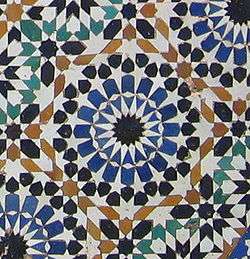
The green and white zellīj at the top of the minaret of the Kutubiyya Mosque, constructed in Marrakesh under the Almoravid dynasty, dates back to around 1150.[1] The Moorish art of zellīj flourished during the Hispano-Moresque period of the area known as Al-Andalus (modern day Spain and Portugal) between 711–1492. The technique was highly developed during the Nasrid dynasty, Marinid dynasty and Zayyanid dynasty who gave it more importance around the 14th century and introduced blue, green and yellow colours. Red was added in the 17th century. The old enamels with the natural colours were used until the beginning of the 20th century and the colours had probably not evolved much since the period of Merinids. The cities of Fes and Meknes in Morocco, remain the centers of this art.
Patrons of the art used zellīj historically to decorate their homes as a statement of luxury and the sophistication of the inhabitants. Zellīj is typically a series of patterns utilizing colourful geometric patterns. This framework of expression arose from the need of Islamic artists to create spatial decorations that avoided depictions of living things, consistent with the teachings of Islamic law.
Clays for zellīj
Fez and Meknes in Morocco are still the production centers for zellīj tiles due to the Miocene grey clay of Fez. The clay from this region is primarily composed of kaolinite. For Fez and Meknes, the clay composition is 2-56% clay minerals, calcite 3-29%. Meriam El Ouahabi states that:
From the other sites (Meknes, Fes, Salé and Safi), the clay mineral composition shows besides kaolinite the presence of illite, chlorite, smectite and traces of mixed layer illite/chlorite (Fig. 3). Meknes clays belong to illitic clays, characterized by illite (54 – 61%), kaolinite (11 – 43%), smectite (8 – 12%) and chlorite (6 – 19%) (Fig. 3). Fes clays have a homogeneous composition (Fig. 3) with illite (40 – 48%). and kaolinite (18 – 28%) as the most abundant clay minerals. Chlorite (12 – 15%) and smectite (9 – 12%) are generally present as small quantities. Mixed layer illite/chlorite is present in trace amounts in all the examined Fes clay materials.[7]
Forms and trends
As the colour palette of the zellīj tiles increased over the centuries, it became possible to multiply the compositions ad infinitum. The most current form of the zellīj is a square. Other forms are possible: the octagon combined with a cabochon, a star, a cross, etc. It is then moulded with a thickness of approximately 2 centimetres. There are simple squares of 10 by 10 centimeters or with the corners cut to be combined with a coloured cabochon. To pave an area, bejmat, a paving stone of 15 by 5 centimetres approximately and 2 centimetres thick, can also be used.
An encyclopedia could not contain the full array of complex, often individually varied patterns and the individually shaped, hand-cut tesserae, or furmah, found in zillij work. Star-based patterns are identified by their number of points—'itnashari for 12, 'ishrini for 20, arba' wa 'ishrini for 24 and so on, but they are not necessarily named with exactitude. The so-called khamsini, for 50 points, and mi'ini, for 100, actually consist of 48 and 96 points respectively, because geometry requires that the number of points of any star in this sequence be divisible by six. (There are also sequences based on five and on eight.) Within a single star pattern, variations abound—by the mix of colors, the size of the furmah, and the complexity and size of interspacing elements such as strapping, braids, or "lanterns." And then there are all the non-star patterns— honeycombs, webs, steps and shoulders, and checkerboards. The Alhambra's interlocking zillij patterns were reportedly a source of inspiration for the tessellations of modern Dutch artist M.C. Escher.[8]
Themes often employ Kufic script, as it fits well with the geometry of the mosaic tiles, and patterns often culminate centrally in the Rub El Hizb. The tessellations in the mosaics are currently of interest in academic research in the mathematics of art.

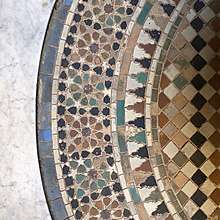
- Detail of Bab al-Mansour in Meknes
 Place El-Hedine, Meknes
Place El-Hedine, Meknes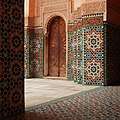 Ben Youssef Madrasa in Marrakesh
Ben Youssef Madrasa in Marrakesh Zellige fragment from Tilemsan in the 14th century.
Zellige fragment from Tilemsan in the 14th century..jpg) Classic motif and colors of the 14th century in the Alhambra.
Classic motif and colors of the 14th century in the Alhambra. Nasrid Palace, Alhambra
Nasrid Palace, Alhambra Mahkamat al-Pasha in Casablanca.
Mahkamat al-Pasha in Casablanca. Tomb of Lalla Masuda at the Saadian Tombs
Tomb of Lalla Masuda at the Saadian Tombs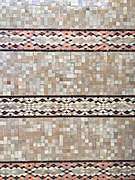 Edmond Brion's reinterpreted zellige at Bank Al-Maghrib in Casablanca.
Edmond Brion's reinterpreted zellige at Bank Al-Maghrib in Casablanca.
These studies require expertise not only in the fields of mathematics, art and art history, but also of computer science, computer modelling and software engineering,[9] all used for the Hassan II Mosque.
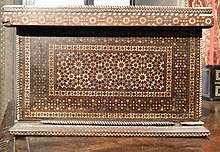
Islamic decoration and craftsmanship had a significant influence on Western art when Venetian merchants brought goods of many types back to Italy from the 14th century onwards.[10]
Zellīj craftsmanship
Zellīj making is considered an art in itself. The art is transmitted from generation to generation by maâlems (master craftsmen). A long training starts at childhood to implant the required skills.[11] In 1993, the Moroccan government abolished the practice of teaching young children starting at ages 5 to 7, when the Convention on the Rights of the Child (CRC) was ratified.[12] Now young people learn zellīj making at one of the 58 artisan schools in Morocco. However, the interest in learning the craft is dropping. As of 2018, at an artisan school in Fez with 400 enrolled students only 7 students learn how to make zellīj.[13]
Assiduous attention to detail is needed when creating zellīj. The small shapes (cut according to a precise radius gauge), painted and enamel covered pieces are then assembled in a geometrical structure as in a puzzle to form the completed mosaic. The process has not varied for a millennium, though conception and design has started using new technologies such as data processing.
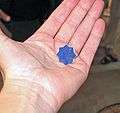 An eight sided star tile after being cut from a tile, a mainstay of Moorish/Islamic design
An eight sided star tile after being cut from a tile, a mainstay of Moorish/Islamic design Artisan workers chipping zellige pieces, Fez, Morocco.
Artisan workers chipping zellige pieces, Fez, Morocco. Loose tiles after chiseling the main glazed tile. Fez, Morocco.
Loose tiles after chiseling the main glazed tile. Fez, Morocco. Zellige being assembled for an installation in Fez, Morocco.
Zellige being assembled for an installation in Fez, Morocco.
Further reading
- at-Tanwīr wa-Diwān at-Tahbīr fi Fan at-Tastīr (التنوير وديوان التحبير في فن التسطير) by Khalid Saib (in Arabic)[14]
See also
References and notes
- Ruggles, D. (1999-04-22). "D. Fairchild Ruggles. Review of "The Minbar from Kutubiyya Mosque" by Jonathan M. Bloom". caa.reviews. doi:10.3202/caa.reviews.1999.75. ISSN 1543-950X.
- L'Opinion (May 6, 1992)
- Broug, Eric (2008). Islamic Geometric Patterns. London: Thames & Hudson. ISBN 978-0-500-28721-7.
- Team, Almaany. "تعريف و شرح و معنى زليج بالعربي في معاجم اللغة العربية معجم المعاني الجامع، المعجم الوسيط ،اللغة العربية المعاصرة ،الرائد ،لسان العرب ،القاموس المحيط - معجم عربي عربي صفحة 1". www.almaany.com. Retrieved 2020-05-29.
- "azulejo – definition of azulejo in Spanish". Oxford Living Dictionaries. Oxford University Press. Archived from the original on 8 April 2019. Retrieved 8 April 2020.
- "Azulejos: gallery and history of handmade Portuguese and Spanish tiles". www.azulejos.fr. Retrieved 8 April 2020.
- El Ouahabi, Meriam (2014). "Mineralogical and geotechnical characterization of clays from northern Morocco for their potential use in the ceramic industry". Clay Minerals. 49: 35–51.
- Werner, Louis. 2001. "Zillij in Fez." Saudi Aramco World. May–June 2001. Volume 52 (3). Pages 18–31.
- From Form to Content: Using Shape Grammars for Image Visualization, Source IV archive Proceedings of the Ninth International Conference on Information Visualisation (IV'05) – Volume 00, IEEE Computer Society Washington, DC, USA
- Mack, Rosamond E. (2001). Bazaar to Piazza: Islamic Trade and Italian Art, 1300-1600. University of California Press. pp. Chapter 1. ISBN 0-520-22131-1.
- beton-decoratif.com
- "Lonely Servitude | Child Domestic Labor in Morocco". Human Rights Watch. 2012-11-15. Retrieved 2019-05-22.
- "Crafting mosaic tile is an endangered tradition. Here are the folks keeping it alive". USA TODAY. Retrieved 2019-05-22.
- خالد،, السايب، (2016). كتاب التنوير وديوان التحبير في فن التسطير (in Arabic). ISBN 978-9954-37-649-2.
- Some of the content of this article comes from the equivalent French-language Wikipedia article, accessed January 3, 2007.
- Moroccan Ceramics and the Geography of Invented Traditions, Journal article by James E. Housefield; The Geographical Review, Vol. 86, 1997
- The Elements of Unity in Islamic Art As Examined Through the Work of Jamal Badran, By Fayeq S Oweis
- Engineering and fine arts research collaborations sprout from seed grants, By Scott McRae, Concordia's Thursday Report, Vol. 29, No.1, September 9, 2004
- Technical Glossary, Islamic Art Network, Thesarus Islamicus Foundation, Islamic Art Network 21 Misr Helwan al-Ziraa‘i St., 9th Floor, Al-Ma'adi, Cairo, Egypt
External links
| Wikimedia Commons has media related to Zellige. |

.jpeg)
.jpg)